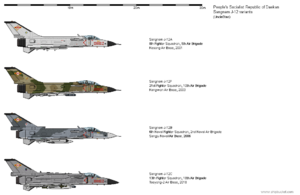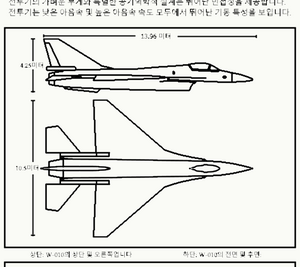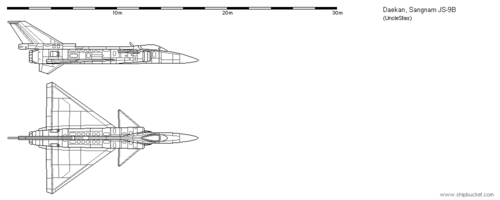Sangnam J-12
This article is incomplete because it is pending further input from participants, or it is a work-in-progress by one author. Please comment on this article's talk page to share your input, comments and questions. Note: To contribute to this article, you may need to seek help from the author(s) of this page. |
| Sangnam J-12 | |
|---|---|
 Main J-12 variants (note the conformal fuel tanks on the C model) | |
| General information | |
| Type | fighter, Multirole Fighter |
| Manufacturer | Sangnam Aircraft Design Bureau |
| Status | In service |
| History | |
| Manufactured | 1992-today |
| Introduction date | 23 May 1995 |
The Sangnam J-12 (전투기 12; Jeontugi 12; Fighter (No.) 12) is a single-engine, lightweight multirole fighter aircraft in the delta and canard configuration, developed and produced by the Sangnam Aircraft Design Bureau for the Daekanese People's Army. The J-12 is capable of all-weather operations and is equipped with fly-by-wire controls. The J-12 entered service in 1995 and forms the backbone of the Daekanese People's Army Air Force, while it also operated the naval aviation of the Daekanese People's Army Navy.
While the first variants were originally oriented as a dedicated air-superiority fighters, in subsequent modifications and upgrades the J-12 has evolved into a multi-role aircraft capable of being used in the air-to-ground role with both unguided and precision guided munitions. Later variants are also capable of aerial refueling and can also fit conformal fuel tanks (CFTs), significantly increasing their operational range. The J-12 has been exported to several nations, most notably Pakiranistan, which is the aircraft's second largest operator after Daekan.
Development
The ChJJ program
By the late 70s and early 80s, the most modern and capable Daekanese fighter was the Sasngnam J-9, a local design based on elements of the Vanquarian MiG-23 which had entered service in 1978. While the J-9 had proven capable against older FA-30s and F-5s in the 1979 invasion of Gogsan, its drawbacks were also showcased. The recent introduction of fourth-generation fighter aicraft by hostile and potentially hostile states, such as the F-15 and F-16 or the Valaran FA-42 Varja I, intensified the concern that the DPAAF would remain too far behind. Many within the DPAAF and general DPA leadership expressed the opinion that compared to those designs, the J-9 was obsolete at the date of its introduction into service.
As a result, the National Defence Council issued the "order for the research and production of next-generation fighters" in June 1980 which resulted in the launching of the ChJJ (차세대 전술 전투기; Next-generation Tactical Fighter) program being launched officially in september. The ChJJ program called for all major aircraft-design corporations in Daekan to design a "frontline tactical fighter for the air superiority role". The NDC order and subsequent program was oppossed by the so-called "Vanquarian lobby", a group of government and DPA officials who favoured purchasing aircraft from Vanquaria, particularly the MiG-29 which was then in development.
The W-010/J-10
The two forerunners of the ChJJ program were the Anseon Aircraft Corporation (now Anseon Aerodynamics) and Sangnam Aircraft Design Bureau, which traditionally were the most well-established aircraft designers in the country. Both presented their designs to the Equipment Development Department of the National Defence Committee (EDD-NDC) by late 1981. The Anseon design was a large, two-engine air superiority fighter similar to the F-15 and Su-27, and impressed the EDD-NDC and DPAAF repressentatives with its projected capabilities. The Sangnam Bureau's design on the other hand, was a smaller single-engine fighter similar to the F-16, aimed at being a more economical alternative. The deteorating Daekanese at the time pushed the EDD-NDC to recommend the adoption of the Sangnam design, which was officially greenlit for further development in April 1982. The Anseon design, on the other hand, was shelved but the base design was later used in what eventually became the Anseon J-14.
Sangnam continued work on the ChJJ design into 1983 despite pressure by the some government circles to abort the project due to the worsening economic situation of the country. In March, a full size mockup of the design, which was given the prototype designation of W-010 (and would presumably be adopted as the J-10 into service) was presented to officials and Sangnam was then ordered to build a fully fledged prototype by the years end. However, their funding had been halved as a result of the 1982-1984 Daekanese economic crisis, which complicated the construction of the prototype. The necessary avionics were hard to come by, and a stopgap measure of using equipment from the J-9 for the first prototype was deemed unnacceptable by the head of Sangnam ADB, Mok Ji-Hae. In a final blow to the project, the purchase of Klimov RD-33 afterburning turbofans from Vanquaria, which would constitute the W-010's powerplant, was cancelled.
The W-010 project was finally cancelled in September of 1983. The half-built prototype was destroyed in 1985 in an industrial accident in one of Sangnam ADB's warhouses.
Design
Airframe
Engines
Electronics and Avionics
Operational history
 Daekan: The Daekanese People's Army Air Force is the main operator of the J-12, with 80 J-12As, 140 J-12Bs and 40 J-12Cs in service. The Daekanese People's Army Navy Air Force operates 30 J-12Bs.
Daekan: The Daekanese People's Army Air Force is the main operator of the J-12, with 80 J-12As, 140 J-12Bs and 40 J-12Cs in service. The Daekanese People's Army Navy Air Force operates 30 J-12Bs. Pakiranistan: The Pakiranistani Air Force is the second largest operator of the J-12, with 100 J-12PI, 38 J-12PS, and 30 J-12PNG in service.
Pakiranistan: The Pakiranistani Air Force is the second largest operator of the J-12, with 100 J-12PI, 38 J-12PS, and 30 J-12PNG in service. Kamdai: The Kamdai People's Defence Army Air Force operates up to 100 J-12 of different variants.
Kamdai: The Kamdai People's Defence Army Air Force operates up to 100 J-12 of different variants. Kimjak: The Kimjak Liberation Army Air Force operates 24 J-12Bs with an additional 24 on order.
Kimjak: The Kimjak Liberation Army Air Force operates 24 J-12Bs with an additional 24 on order.
Variants
Domestic variants
- W-012-1: Prototype variant. It did not feature canards
- W-012-2: Second prototype variant. Canards were added and the ventral fins were extended
- J-12A: Initial production variant, featuring the LS-78 pulse-doppler radar and Yolam-52A engine.
- J-12P: Two-seat variant of the J-12A.
- J-12B: Upgraded variant introduced in 2006. Includes a larger nose cone to accommodate the new LS-86 pulse-doppler radar, modified vertical stabilizer with housing for an extensive avionics and ECM suite, the more powerful Yolam-60 engine, as well as extended engine cover. Has the capacity to mount conformal fuel tanks.
- J-12BP: Two-seat variant of the J-12B
- J-12C: Latest variant, introduced in 2014. It features a slightly enlarged cockpit for better visibility, lighter and stealthier diverterless supersonic inlets, modified wings with extended leading-edge slats and wingtip hardpoints for missiles. Additionally, it has an improved avionics suite, the upgraded Yolam-60B engine and the new LS-92 active electronically scanned array (AESA) radar.
- J-12CP: Two-seat variant of the J-12C
- J-12D: Upgrade program currently under development. The program includes a new, improved canard design, a 3-D vectoring engine, extensive RAM coating and improved avionics. The prototype flew in January 2020.
- J-12H: Carrier-borne variant based on the J-12B under consideration by the Daekanese People's Army Naval Air Force (DPANAF) for use in the new Jang-gun-class of aircraft carriers.
Export and foreign variants
- J-12S: Export variant of the J-12A offered since 1998 featuring the LS-76 radar. Two-seater variant is the JS-12PS
- J-12SB: Upgraded export variant offered since 2009. It is based on the J-12B, and features the LS-86E radar. Two-seater variant is the JS-12PSB
- J-12SC: Latest export variant offered since 2015. It is based on the JC-12C, and features the LS-91 active electronically scanned array (AESA) radar. Two-seater variant is the J-12PSC.
- J-12PI: Pakirani variant based off of the J-12S, the aircraft has been modified and reequipped for the light interceptor role, it features Pakirani avionics and the AASR-95 radar
- J-12PS: Pakirani Two-Seater variant based off of the J-12PS, the aircraft has been adapted to the strike role, and features the Pakirani ATSTR targeting pod as well as fuselage mounted bomb racks.
- J-12PNG: Latest upgraded Pakirani variant in service since 2012, It is based on the J-12PI, the aircraft features avionics improvements such as the helmet-mounted display and sight (HMD/S) system, the cockpit has been overhauled into one single Multi-Function Display (MFD), as well as incorporating the NGAASR active electronically-scanned array (AESA) radar with rumored infrared search and track (IRST) system capability.
Specifications (J-12B)
General characteristics
- Crew: 1: pilot
- Length: 17.33 ()
- Wingspan: 10.13 ()
- Height: 4.84 m ()
- Empty weight: 10,000 kg kg ()
- Loaded weight: 14,000 kg ()
- Max. takeoff weight: 19,500 kg ()
- Powerplant: 1 × Hyesan Yolam-52A afterburning turbofan
Performance
- Maximum speed: Mach 2.2 (2,336 km/h, 1,451 mph) at high altitude/ 1,110 km/h (690 mph) at low altitude
- Range: 3,600 km with drop tanks ()
- Combat radius: 1,550 km with drop tanks ()
- Service ceiling: 18,000 m (59,000 ft)
- Rate of climb: 310 m/s (61,020 ft/min)
Armament
- Guns: Provision for 2× 27 mm CR-127 cannon, 130 rounds per gun
- Hardpoints: Total of 11: 6 under-wing, 4 under-fuselage, 1 centerline; with a capacity of 7,300 kg (16,093 lb) external fuel and ordnance (C variants have two additional wingtip hardpoints) and provisions to carry combinations of:
- Missiles:
- Air-to-air missiles:
- Air-to-surface missiles
- Bombs:
- MP series of dumb bombs (250 kg and 500 kg bombs)
- GB series of dumb bombs (150 kg, 250 kg, 500 kg and 700 kg bombs)
- YP-5 laser guided bomb
- GGB series of laser guided bombs (250 kg, 500 kg and 700 kg bombs)
- GP-7 glide bomb
- Other:
- LP-20 rocket pod
- LP-32 rocket pod
- Various fuel tanks (up to 3)
- Missiles:
Avionics
TBA



